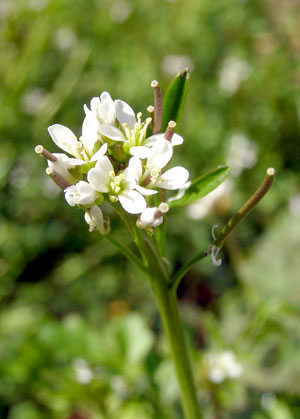Think twice before pulling
By Ken Moore
Flora Columnist
To weed, or not to weed?
Well now, that is a good question. Gardening friend Sally Heiney and I usually agree on which weed to keep and which to toss. We definitely agree on leaving a few pokeweeds every year, frequently comparing notes on who has the larger ones.
But this spring we’ve come to a bit of a crossroads. Sally has taken to weeding my favorite henbits and speedwells from her garden, and with volunteers following her lead, some of my favorite weeds have become forbidden in the developing gardens around the N.C. Botanical Garden’s new visitor center.
And Sally is pulling another favorite little annual weed, the white-flowered bittercress. Cardamine hirsuta is not as showy as the purple henbits and blue speedwells that are still noticeable on the roadsides, where to passing motorists their clumps appear a bit like short shag carpets.
In my wild yard, bittercress is moving in amongst the henbits and speedwells, which are still making a show. This little wild mustard makes solid carpets where the ground was bare last fall.
The tiny white flower of the bittercress exhibits the characteristic four petals of the flowers in the mustard or crucifer plant family, Brassicaceae. At this time every early spring, I pick a few leaves, with a pinch of the flowers and seedpods, to enjoy a spicy, healthy snack.
Last spring, Wendy Wenck, who manages the Botanical Garden’s Mercer Reeves Hubbard Herb Garden, described for me harvesting handfuls of the mustards and enjoying the spicy greens either in a fresh salad or cooked as a potherb. She admitted that it does take lots and lots of handfuls to make even a small dish. Though time consuming, wild foraging, even if only in one’s own garden, is enjoyable and frequently a source of fresh vitamins.
Sally gives me a hard time because this bittercress is a naturalized exotic that I should pull. But I don’t mind that it takes over for short periods; being an annual, I know it won’t compete well with perennials that move in during the growing season.
I’ve learned from Sally that we have a native bittercress growing in our area. Sally is an expert on weeds and I am relying on her to show me the differences between the native and the foreign one.
There’s a spot at the Botanical Garden where they are growing together and she’s saving them for use in her upcoming Weeds 101workshop on March 26. In addition to describing how to recognize common lawn and garden weeds, Sally will recommend strategies for eliminating the undesirable ones. She will also surprise you with her appreciation that some plants we consider weeds may be botanical or garden treasures that we simply don’t recognize before they are mature.
As so often expressed, one person’s flower is another person’s weed. So think twice before pulling any unknown plant. It could grow and flower and make you smile.
Email Ken Moore at flora@carrborocitizen.com.
Read more Ken Moore Citizen columns at The Annotated Flora.



Comments are closed.